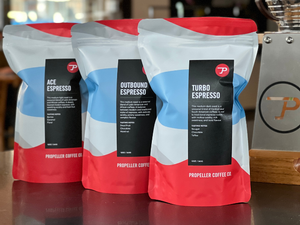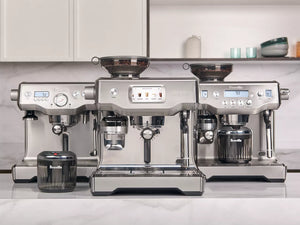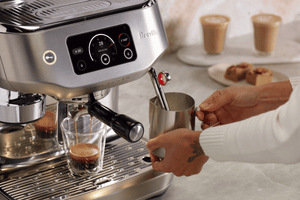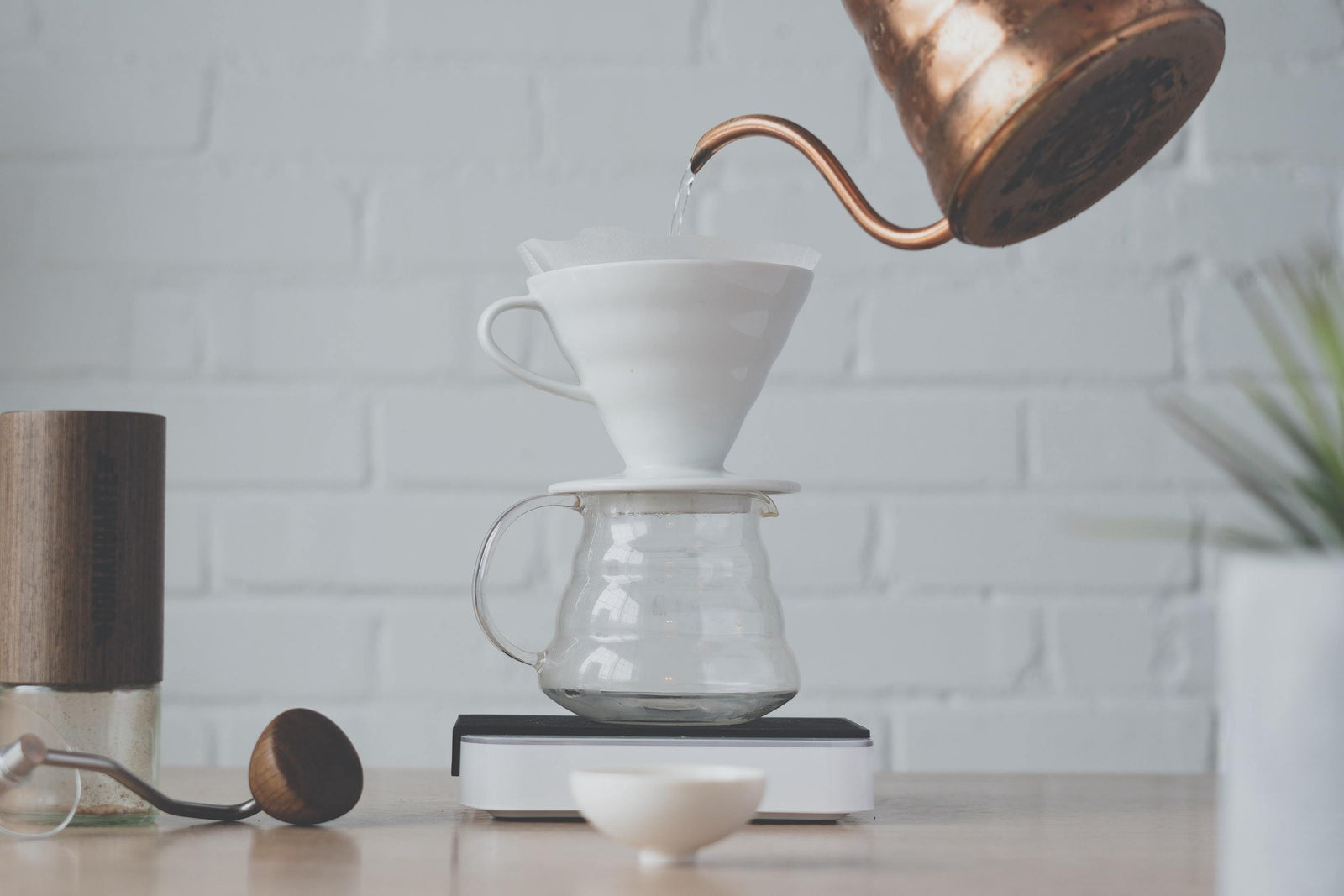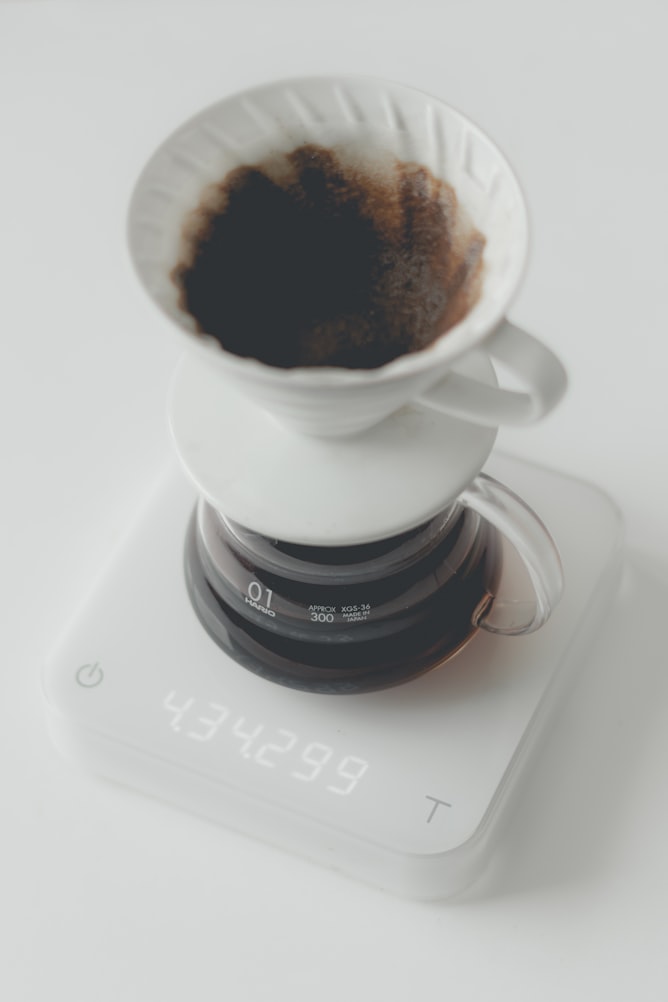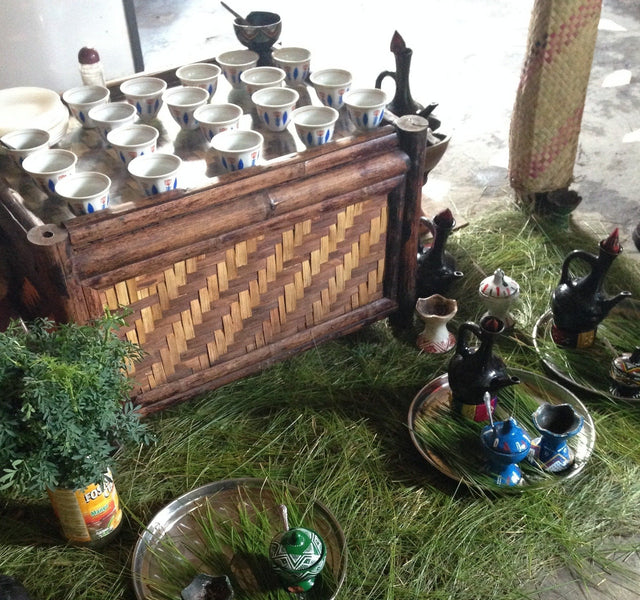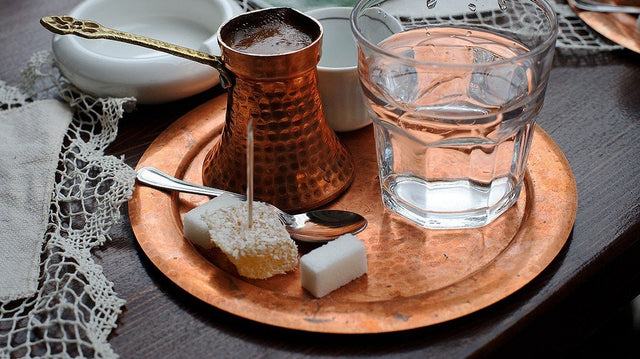Of all the brew styles, the Hario V-60 is a source of constant intrigue and experimentation.
The endless variety of materials - classic ceramic, heat proof glass, plastic, and the universally coveted copper - all have their advantages and quirks, and make this brew style fiercely personal.
A brief history of Hario - Hario started out exclusively producing home and lab-grade glass materials. After years of research and testing, Hario successfully produced environmentally-friendly heatproof glass, made completely from natural materials.
Hario has since pioneered and perfected two of the most iconic brewers in modern coffee lore: the Siphon, and the V60.
As a novel brew method, the Hario V-60 design elements are calculated in their execution:
- The spiralized ribbing running along the sides of the cone allows for better airflow around the coffee bed, which helps prevent the brew from choking
- The 60 degree angle of the cone (the “60” in “V-60” represents this angle!) allows maximum contact time with the coffee bed while preventing over extraction in any specific area
- The large hole at the bottom allows for easy flow of water through the grounds, which - although difficult to master - truly enables you to highlight the qualities of the coffee that you want, making each V60 recipe highly customizable according to pour-style, grind size, and brew time
- Although the V60 originally came in ceramic and glass, the range of materials available now will further affect your recipe: specifically, how long the brewer maintains heat can make all the difference for your recipe, not to mention you have to be extra careful to not chip or break ceramic or glass!
As thoughtfully designed and curated as the V-60 is, your technique is truly what will make or break this brew method.
By manipulating even the tiniest variables - ratios, how coarse or fine your grind is, your pouring technique, and the timing of your brew - you can highlight a myriad of subtle elements, both flavour-wise and mouthfeel, to make it truly yours. Conversely, this is also what makes the V60 so difficult to master.
Some pointers to get the most out of your V60 and out of your coffee:
What coffee should I brew in my V60?
The short answer is - you can brew virtually any type of coffee on a V60.
Blends, such as our staples - Turbo Espresso, Outbound Espresso, Ace Espresso, Foundry, Skyhawk, and even our Swiss Water Decaf - all perform incredibly well and produce a sweet, dependable, and delicious cup of coffee.
However, the true mysteries of the V60 are unlocked when brewing single origin coffees.
Dialing in a single origin coffee is like playing a musical instrument - apply the basics, find your dependable cup and what works with your style, and use your skills and imagination to experiment. Eventually, you’ll come upon an expression of coffee (or music) that is wildly different, yet still balanced and articulate.
My favourite example from our current coffee line-up is our Burundi Gakenke. My first few brews of this coffee brought out notes of sweetness, with light toffee as the backbone throughout and syrupy Grand Marnier-esque cherry notes to compliment the profile. After experimenting, and making some small adjustments to my brew parameters, I am now able to highlight other nuances of the coffee. In some iterations, for example, this coffee is a total fruit bomb - think Swedish Berries fruitiness, with mellow, peach acidity throughout.
My tip for you: grab one of each - one blend, one single origin. Try out different origins - the sweet, chocolatey offerings of Central and South America, or the tea-like, fruit-forward coffees of Africa. This will give you a foundational understanding of which coffees appeal to your palate, and what kinds of flavours your coffee can surprise you with in the cup.
Experiment and have a delicious time!
POUR STYLE
In contrast to other brew styles, the manual element of pouring water over your bed of coffee creates a lot of margin for error. In order to approach mastery of the V60, we need to fine-tune how we distribute hot water over our bed of coffee.
As easy and convenient as it would be to dump all of the brew water into the brewer, allow it to do its thing, and come back to a complex and balanced cup - coffee (and life) do not work like that.
Please note: a gooseneck kettle is critical to being able to make a pourover coffee well. Using a standard kettle ultimately defeats the purpose of a pourover. At the roastery, our favourite gooseneck is the Bonavita Gooseneck, and for a slight up-grade - the Bonavita Gooseneck Variable Temperature model will give you even more control & precision in your brewing. With both of them, the pour is incredibly easy to practice and personalize, and the variable temperature is a rare, endlessly useful feature for a broad variety of coffees and brew styles. As well, for all of you who are tea-lovers as well, the variable temperature model is super useful for brewing teas, which typically benefit from lower temperatures to brew more delicate flavours. You can pick up the kettles from our web store here.
There are a few different pour styles and patterns, especially when you really get into the more technical elements of pourovers. However, we’re going to be focusing on the most straight-forward of the pour styles.
Two elements we will focus on: agitation and saturation
For this method, we always try to pour as slowly as possible. An exercise you can work on at home to perfect your pour - top off your kettle with tap water. Aim for the very centre of the drain in your sink. Start pouring, but pour in such a way that if you pour any slower, your water flow stops completely. As the kettle empties, you will find that the angle you need to maintain this flow will change. Master this flow and the difference in your pourover quality will improve dramatically.
Pouring this gently is important so we can control how the coffee is being extracted in the brewer. Specifically, we are trying to control agitation of the bed of coffee. Too much agitation, and we will start to develop the over-extracted flavours we are trying to avoid. Instead, we will only agitate at two points in the brew: after our first pour (the bloom), and after our last pour. As for the pour pattern itself - when blooming, we are trying to get all of our bloom water into the brewer ASAP, and agitate strategically but quickly. With our consequent pours, we will start pouring gently from the centre in a slow, concentric spiral to the outsides of the brewer. If you see any loose grinds on the sides of the filter, quickly (but gently) run some water over them. Pour over any darker spots you may have missed. Be careful not to run too much water down the sides of the brewer without dissolving any coffee - this is called bypass and will affect the balance of your final brew.
A hallmark of a well-extracted pourover is a flat bed of spent coffee grinds. If the bed has any pock marks, chances are your pour was a bit too heavy handed in those specific areas. Likewise if coffee splashes too far up the sides of your brewer. We are trying to control the flow of water and the movement of the grinds as much as we can, so be careful to pour gently.
GRIND SIZE
Of all the parameters to adjust for your V-60 recipe, grind size is easily the most delicate balance to strike, and arguably will have the most bearing on the outcome of your recipe.
Because of the large hole at the bottom of the brewer, we are going to have to nail down a range of grind sizes. The key here is: if the grind is too fine, the water flow through the coffee bed will be choked by the collection of fine particles pooling at the apex of the cone filter, causing the grinds to over-steep and for the coffee itself to become over-extracted (the point where the dry, astringent natural flavours of the coffee overpower the caramelized sweetness of the brew, throwing off the balance of flavours we seek to achieve).
Conversely, if our grind size is too coarse, our brew water won’t have enough contact time with the coffee bed. Therefore, the brew water is not able to dissolve all of the flavour compounds necessary for us to capture the full spectrum of flavour profile that the coffee has to offer. This is easily diagnosed in two ways: if your brew runs through the V60 quite fast (the water level should slowly recede through the coffee bed versus running through quickly) and the particles look very coarse once your brew is complete, chances are you need to grind finer for your next iteration.
Once we nail the fundamentals and all the nuance of this delicate brew method, you will be able to experience what most consider to be the most layered, delicate, and complex expression of your favourite coffee.
Try out these tips and let us know how your #V60 goes!
Written by: Bear Ranasinghe
